A year and a half ago in a blogpost on sixteenth century Monstreous Rays and Fraudulent Apothecaries, I referred to a description of a sea-creature resembling a winged snake or a dragon from Conrad Gessner’s 1558 Historia Piscium. Last weekend my colleague Robbert Striekwold and I made an attempt at making such a dragon ourselves. Our project at Leiden University, A New History of Fishes, is at the moment organising an exhibition at the Leiden University Library which opens on September 20. If by then we have managed to create a dragon that looks like Gessner’s, this will be put on display. The photo below shows our first, somewhat clumsy, attempt. We used the wrong type of fish, and the result is a far cry from Gessner’s dragon. However, we will continue to try, and so this blogpost is the first of a series.

Gessner described how sea-monsters were made out of rays, often by apothecaries who displayed them in their shops. For more information on these monstrosities, nowadays known as Jenny Hanivers, I refer to my previous blogpost. For now, let’s return to Gessner’s text for a moment.
“Apothecaries and others”, he writes, “let the body of the ray dry and twist the skeleton, making the animal look like a winged serpent or a dragon. They bend the body and alter the shape of the head and mouth, and cut other parts off. The forward part of the wings is cut away, and what is left is turned upright, making the animal look like it has wings”

Conrad Gesner. Historiae animalium liber IIII. Zurich, Christoph Froschauer, 1558. SUB Göttingen HSD
Gessner complained that ordinary people were easily impressed by such things, referring to the fact that such man-made monsters were often exhibited and people would readily pay to see them. Jenny Hanivers were therefore no rare sight. Gessner’s acquaintance, the naturalist Ulysse Aldrovandi (1522-1605) depicted no fewer than five of them.

Ulysse Aldrovandi. De piscibus. Bologna, Baptiste Bellagamba, 1613. Université Louis Pasteur from University of Strasbourg.
To us this suggested that they might not be so difficult to make, and armed with Gessner’s instructions we set out to try this for ourselves. However, we faced several challenges, beginning at the fish market. Rays, I had been told, are at their leanest and therefore not sold during the summer. However, with a few days notice, my fishmonger could get me one. Unfortunately, when I came to collect my ray, it had been chopped up and neatly wrapped up with a lemon and a bunch of parsley. Unable to get another ray at short notice, Robbert and I decided to practice on the scariest looking thing we could find, a monkfish (Lophius piscatorius).
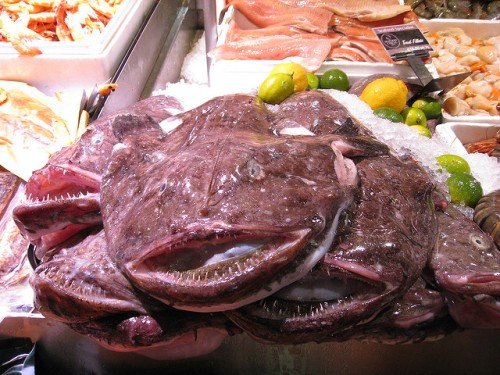
Photo: Kai Henry
Of course monkfish are nothing like rays, and, because they are much more fleshy, much less suitable for our purpose. Nevertheless, we got to work. We knew certain parts of the fish would be impossible to preserve, so our first step was to remove those, beginning with the eyes.
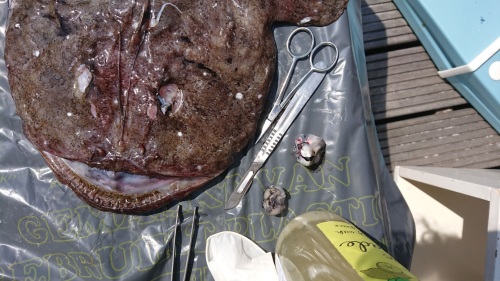
Then we turned our fish over and began to remove as much flesh as possible, leaving the bone and the skin. This would make it easier to twist and shape, and would hopefully leave us with something that would easily dry in the sun. Having chosen a hot day for our experiment, we were hopeful. Monkfish have a thick spinal cord and no small bones, and so, using a standard dissection kit, we were able to easily remove almost all of the flesh from the tail. The head however, contains a lot of cartilage and we couldn’t get to the fleshy parts.
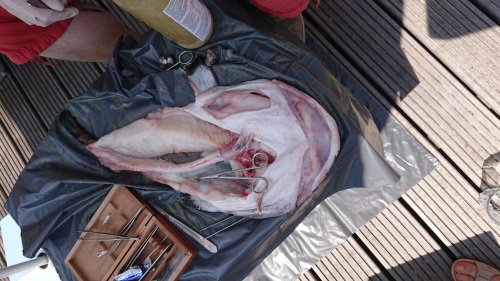
Not wanting to let this discourage us, we began to shape our fish. Because Gessner’s instructions applied to rays, we abandoned them and used our imagination. We decided to spread out the pectoral fins and lift them to make them look like wings, twist the tail and spread out the dorsal fin, and open the mouth wide for a scary finishing touch. Then of course everything had to be kept in position until it dried. We began with the tail, and pinned the tail fin down. All the while, we kept spraying water on our fish to keep it from drying out before we’d shaped it.
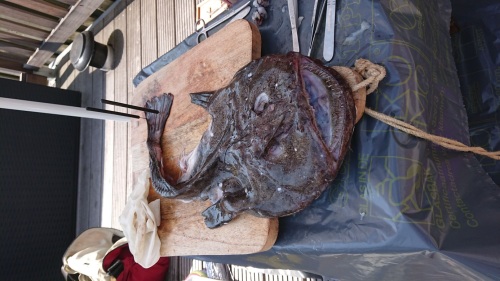
The next step was to spread out and lift the dorsal fin. This was easy enough, but then we had to keep it like this until it was dry. Some wooden building blocks my son no longer plays with came in useful. We propped one up against the fin and used a pipe cleaner to provide extra support.
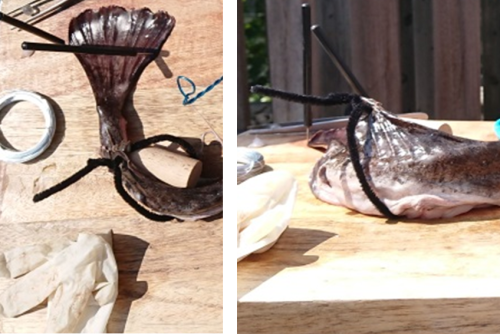
Then we spread out and lifted the pectoral fins, using the same system. We propped them up using blocks, then used aluminium wire for extra support. This accomplished, we added pipe cleaners to hold up the filaments on the head. By now our fish was beginning to somewhat resemble Frankenstein’s monster.
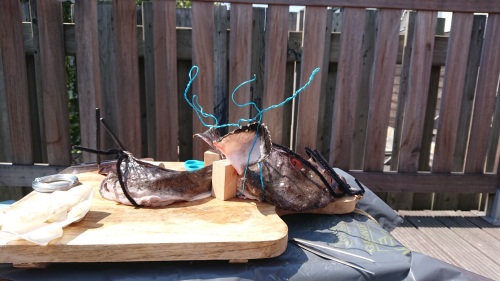
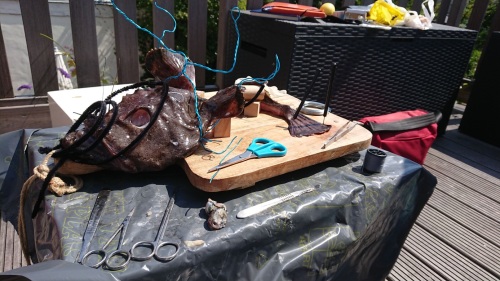
We moved on to the head, again using building blocks and wire. We wrapped the wire around the head and stuffed one of the blocks into the mouth. And just like that we were done, now all we had to do was leave our creation out in the sun and hope for it to dry.
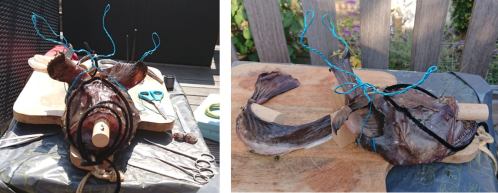
And here comes the sad part. After a long and well deserved lemonade break during which we named our monster Oscar, we returned to find the fins fairly dry but everything else more or less like we left it. By now it was late afternoon, Robbert had to go home and we left Oscar on my roof terrace, hoping he would magically dry while my family and I had dinner.

That evening, once the kids were in bed, my husband and I went to check on Oscar. He had begun to dry out but still had a long way to go, and the sun was going down. Not wanting to give up, and not wanting to leave Oscar unprotected in case the neighbourhood cats would feast on him, we put him on salt and in a box.

The next morning I went to check on him. The salt had little to no effect, Oscar was still wet. And so, once again I left him out in the sun and hoped for the best.

It was not to be. By evening, Oscar had begun to decompose and smell. He was also attracting flies.
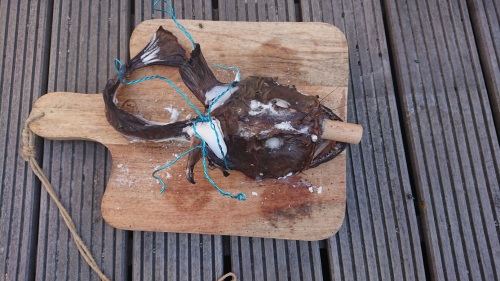
It was time to make a decision. And so Oscar went into the bin…

Nevertheless, Oscar taught us a few valuable lessons. Making a dragon like Gessner’s is fairly easy, however drying it proves difficult. In this case, we did not manage to remove quite enough flesh, but this may be easier working with rays, as Gessner prescribes. And while we hoped that leaving Oscar out in the sun and putting him on salt would do the trick, we should keep in mind that Gessner does not explain how to dry the fish, therefore we may have to consider other methods.
This weekend we will try again. This time using a ray and following Gessner’s instructions to the letter. To be continued..
Further reading:
Pierre Belon. De aquatilibus. Paris, Charles Estienne, 1553.
Conrad Gesner. Historiae animalium liber IIII. Zurich, Christoph Froschauer, 1558.
Ulysse Aldrovandi. De piscibus. Bologna, Baptiste Bellagamba, 1613.
Sophia Hendrikx. Het eerste en misschien ook wel het kleinste en mooiste boek over waterdieren. In: Hans Mulder en Erik Zevenhuizen (Red.), De natuur op papier. 175 jaar Artis Bibliotheek. Amsterdam, Athenaeum-Polak & Van Gennep, 2013.
Peter Dance. Animal frauds and fakes. Maidenhead, Berkshire, Sampson Low, 1976.
© Sophia Hendrikx and Fishtories, 2018. Unauthorised use and/or duplication of this material without express and written permission from this site’s author and/or owner is strictly prohibited. Excerpts and links may be used, provided that full and clear credit is given to Sophia Hendrikx and Fishtories with appropriate and specific direction to the original content.